|
1.
CENTRAL/ WEST AFRICA
Far East demand stays firm and active
Prices remained largely unchanged in the second half of August while markets were quiet during the last part of the
summer holiday. Only bomanga logs (Brachystegia laurentii) showed some signs of increased demand for Far
East destinations. China had increased its purchases of
sawn lumber from Gabon and Cameroon, especially okoume, okan and lots of shorts, strips and squares for
flooring manufacture. Demand for India was also steady, particularly for belli, padouk and, of course, teak. The
price increases reported at the end of July had held firm.
In contrast, export from Congo and Central Africa Republic consisted mainly of logs and limited volumes of
sawnwood and other processed products. Heavy rains were affecting logging in Cameroon, where producers
continued to focus on production of sawnwood and further processed timber as part of the successful downstream
policy introduced some years ago, which was being
emulated by Gabon.
Mills report orders for up to 4 months
West African mills, in general, reported good business in sawn lumber with positive demand for European as well as
Far East markets. Many mills also reported good orders for up to 4 months forward. It was expected that the
enquiry rate would pick up further over the next few weeks, holding prices stable and firm at current levels.
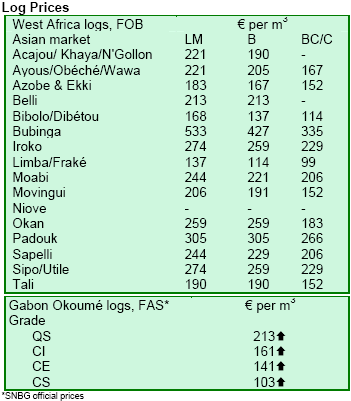
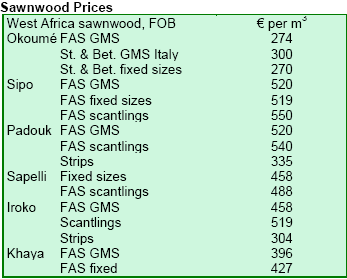
2. GHANA
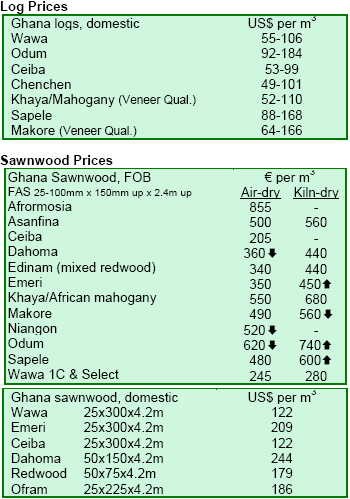
3.
MALAYSIA
Firm demand props up timber prices to fresh highs
The strong demand for Malaysian timber products combined with short supply has sent prices to fresh high
levels. Meranti and kapur logs reached 13- and 10-year highs, exceeding 1997 Asian pre-crisis levels, while dark
red meranti sawnwood prices are at all time high in US dollars since ITTO started to track this product in 1998.
However, these prices are only at a 6-year high in euros or UK pounds. Meanwhile, prices for dark red meranti
plywood are at a ten-year high, also exceeding 1997 Asian pre-crisis levels, except 9mm.
Plywood prices in Malaysia are expected to remain high in the near future. Apart from the rainy season that has
pushed prices for logs upward, demand from Japan, China and India are helping to keep prices high.
Malaysia's
export of plywood in the first half of 2006 was reported to be at 2 million m3, with over 60% of this volume bound
for Japan.
EU and Malaysia kick off formal VPA talks
Malaysia and the European Commission (EC) in Malaysia are in the process of kick start negotiations for the signing
of a bilateral voluntary partnership agreement (VPA) to ensure the sustainability and legality of timber being
exported to the EU. A delegation of Malaysia would be
heading to Brussels in mid-September to officially launch the negotiations.
Pre-negotiations between EU and Malaysia for a landmark Voluntary Partnership Agreement (VPA) begun early this
year led by Thierry Rommel, representative of the European Commission (EC) in Malaysia. The VPA is part
of EU's Forest Law Enforcement, Governance and Trade (FLEGT) initiative aimed at establishing a trading system
and a licensing mechanism to curb the sale of illegal timber products to the
EU.
Malaysia launches Ninth Malaysian Plan 2006-2010
The Malaysian government has launched its Ninth Malaysia Plan 2006-2010, a comprehensive five-year
national development plan. According to the plan, the timber industry in Malaysia is expected to remain a major
contributor to export earnings. By 2020, export earnings from downstream and value-added products, such as
furniture, panel products, MDF and plywood, are
projected to reach 53 billion ringgit ($14.4 billion).
To remain competitive, the timber industry would require expanding the utilization of technological automation as
well as enhancing the use of human capital. Although such technology is already available, the industry is reluctant to
invest in automation as cheap foreign labour is available
and most small and medium enterprises (SMEs) face financial constraints. Furthermore, the furniture industry
would need to move up the value chain in order to remain competitive in the global marketplace. This would require
the industry to undertake designing and branding of its own products to become own design manufacturers
(ODM) and own brand name manufacturers.
The total investment of the timber industry for the Ninth Malaysia Plan 2006-2010 period is targeted at 25.4 billion
ringgit or 1.7 billion ringgit a year. Exports are projected to grow at an annual rate of 6.4% to reach 53 billion
ringgit by year 2020. To achieve the targets set for the industry, eight strategic thrusts have been put in place:
1. Developing regional production and supply chain;
2. Promoting the efficient and effective management of forest resources and forest plantations;
3. Expanding market access through intensified marketing and the promotion of Malaysia ¡®green¡¯
image;
4. Developing and promoting the growth potential in:
• Utilization of lesser promoted species, non-wood fibres and wood waste materials;
• Production of higher value-added wood products.
5. Expanding the production of own design and brand furniture;
6. Enhancing R&D and technological development;
7. Increasing the supply of skilled workforce; and
8. Strengthening the institutional support and improving the delivery system related to the industry.
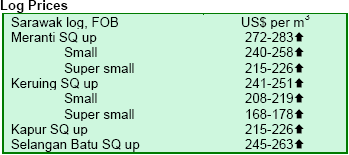
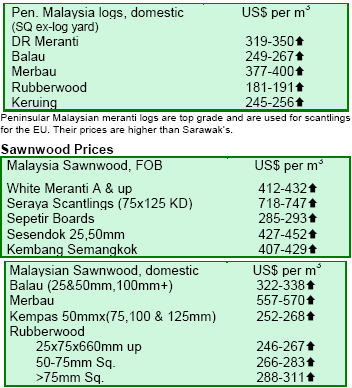
4.
INDONESIA
Indonesian timber prices resume upward trend
Prices of Indonesian timber resume their rise as a result of more aggressive measures taken by the Indonesian
government to clamp down on illegal logging. There were serious concerns among Indonesian legislators that poor
law enforcement against illegal logging may eventually lead to market restrictions in Europe and the USA, amid
sharp criticism by conservationists at home and abroad.
Furthermore, while prices of Indonesian timber products had been stable by logging in natural forests and
plantations in the wake of the annual slash and burn season over recent months, higher transportation costs
were beginning to put a damper on log flows. Workers need to be transported by trucks and other heavy vehicles
moved into the forests. Owners of timber concessions have
had no choice but to pass on the costs to buyers.
Closure of plymills drives prices up in Southeast Asia
Prior to the Asian financial crisis of the 1990s, Indonesia was exporting between 9-10 million m3 of plywood per
year. According to industry sources, it only exported 3.4 million m3 of plywood in 2005 and was expected to reduce
exports further in 2006. The closure of 66 plywood mills in 2005 was having a bearing on the Indonesian plywood
sector. While Indonesia is now enjoying a boom in exports to the USA, she has not been able to meet demands from
larger buyers in the Far East, resorting in prices being driven upwards in Southeast Asia.
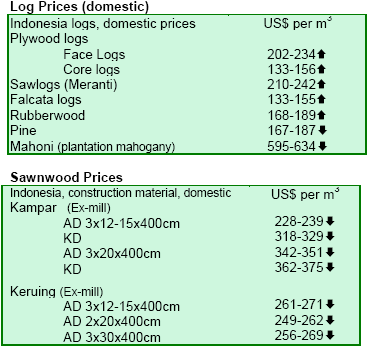
5.
MYANMAR
Teak log prices lose further ground
Tender prices for teak log prices (veneer quality) declined sharply at the sealed tender held on 25 August and the
open tender held on 28 August. In contrast, teak log prices, sawing quality, showed mixed results with price drops not
as pronounced as those for veneer quality.
The market for pyinkado and old gurjan (keruing) logs has not been active. The pyinkado market has not recovered
yet from the recent price increase, while the market for fresh gurjan logs has shown some activity.
Myanmar Furniture Fair 2006
The Myanmar Timber Enterprise (MTE) and the Myanmar Forest Products and Timber Merchants Association are
jointly organizing the Myanmar Furniture Fair-2006 in Yangon on 21-25 October. Interested parties may visit
MTE's website www.myanmatimber.com.mm for further information.
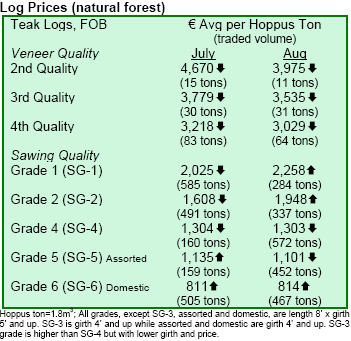

6. PAPUA
NEW GUINEA
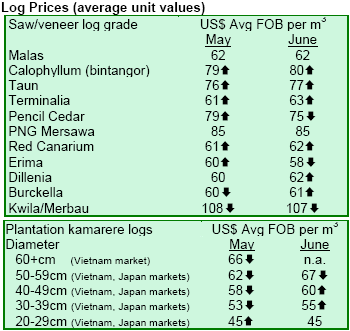
7.
BRAZIL
Softwood plywood exports to the USA plunge
Brazilian softwood plywood exports to the USA plunged 22% in the first half of 2006, the first year-on-year decline
since 2000. Exports from Brazil, USA's largest softwood plywood supplier, have been severely affected by the 8%
US duty. Higher log costs and unfavourable exchange
rates also contributed to the decline. Further declines are expected as major Brazilian producers have announced
cuts in production and shipments to the USA in view of low price levels (see TTM 11:15). Meanwhile, USA is
increasing imports from Chile, China and Uruguay.
Timber sector urges resumption of FMPs
As it was the case in 2005, the forest-harvesting season in Northern Brazil is being threatened in 2006. The bulk of
the Terms of Behaviour Adjustment (TAC), well received by the timber sector as an alternative to reactivate the
suspended Forest Management Plans (FMPs) and to guarantee industrial wood supply, has so far not been
implemented by IBAMA. This institute has reactivated
only six FMPs since September 2005, prompting firms to request quick measures to save the 2006 production
season.
The new Law of Public Forests Management requires owners of FMPs to sign a contract with the Ministry of
Environment. The delay in addressing the problem has affected the solid-wood industry, which is the second
largest exporter in ParĄ§¢ and accounts for about 183,000 jobs. In the municipality of Altamira, along the
TransAmazon road, about 50% of the forest companies have closed operations and laid-off 9,000 employees.
Similar cases had occurred in other solid-wood producing areas.
Furniture producers raise imports to reduce costs
The loss of competitiveness suffered by furniture manufacturers of the São Bento do Sul cluster, Santa
Catarina, has compelled the substitution of domestic with imported raw materials in order to reduce production costs
and to compete with Asian products. The loss of competitiveness has been caused primarily by a weak US
dollar and increasing production costs.
The share of imported raw materials is now reported to account for 10-30% of furniture producers¡¯ input costs.
According to the Brazilian Association of Furniture Industry (ABIMÓVEL), the costs of imported MDF from
Argentina and Chile were 12% cheaper than similar domestic products. Furniture manufacturers are also
importing hardware from China, glue from the USA, some types of varnishes from Chile and even pine timber from
Argentina. According to the Association of Wood Panel Industry (ABIPA), imports of plywood, MDF and
fiberboard increased 10% in the first semester of 2006 compared with the same period in 2005. However, the
association did not foresee full substitution of domestic raw materials.
Brazilian Production of MDF surges 12%
The Brazilian production of MDF reached 1.53 million m3 in 2005 and was expected to expand further as major
companies plan to increase production by 826 m3 a year. MDF production in Brazil has increased 12% in the first
four months of 2006, according to the Brazilian Association of Wood-based Panels Industry
(ABIPA). Excluding new plants being completed, the Brazilian MDF
industry has an installed capacity of 1.7 million m3 a year and was working at about 90% of this capacity.
Production and exports of pulp & paper set to grow
The Brazilian production of pulp is expected to grow 6.3% to 11 millions tons in 2006, according to the Brazilian
Society of Forestry. Similarly, paper production would expand 1.8% to 8.8 million tons while exports of these
products are expected to rise 14% to $3.9 billion.
State of Para creates new state forest
The Northern State of ParĄ§¢ will create the Paru State Forest, an area of 3.6 million ha near the Amazon River.
This will be the country's largest conservation unit for sustainable use and the second largest among all
conservation unit categories. The area was created under and will be regulated by the recent Law of Public Forest
Management (Law 11.284/06).
The creation of Paru was based on a study prepared by Imazon (The Amazon Institute of People and Environment),
which recommended the harvesting of 3-5 trees (less than 2%) per ha. About 60% of the forest area would be
managed, 20% would remain untouched and the remaining
area would accomodate other activities such as ecotourism. Forest communities located in the region of
influence of Paru will have their land and forest harvesting rights guaranteed.
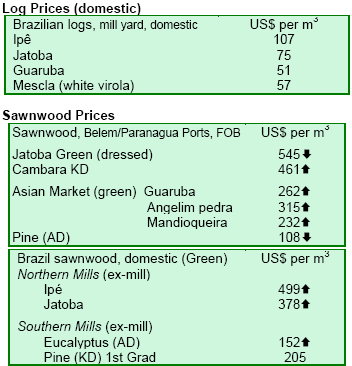
8. PERU
Demand for mahogany eases in recent months
The demand for mahogany sanwood in international markets has declined in recent months, creating
uncertainty among harvesters. Some loggers have even halted activities in production zones. According to some
operators, demand had decreased 15% over the last three months, compared with the same period in 2005.
Meanwhile, the price of mahogany at sawmill yard has
fallen 13% since early June. Exporters of mahogany products indicated that, as a result of problems associated
with the issuing of CITES certificates, customers were looking for substitutes such as Spanish cedar
(Cedrela odorata).
CFA's forest undergoing certification process
SmartWood is evaluating forest management and chain of custody of Amazon Forest
Partnership's (Consorcio Forestal Amazonico, CFA) natural forest concessions, which include four concessions in Ucayali (Parts and
Pieces, Shihuahuaco, Anaconda and Safi Peru, with a total area of 181,000 ha) and two in Madre de Dios
(Maderacre and Maderyja, covering 90,000 ha). Environmental, forestry and socio-economic aspects of the
Partnership's
forest operations in the concessions will be evaluated at the end of August using
FSC-Peru's "Peruvian Standards
of Certification of Forest Management for Timber Products of the Peruvian Amazon" guidelines.
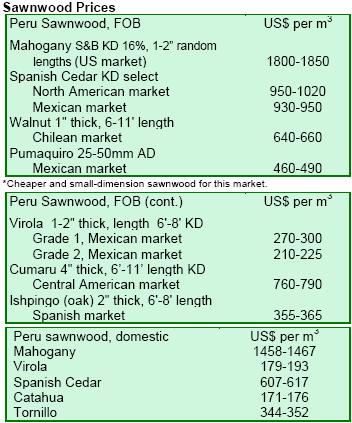
9. BOLIVIA
Sector generates 63,000 jobs and $300 million in sales
According to a recent study funded by the Swedish Agency of Cooperation (SIDA) and carried out by the
Bolivian Forestry Chamber (CFB), Industry and Commerce Chamber (CAINCO) and Private University of
Santa Cruz (UPSA), the wood sector has created almost 63,000 direct jobs in Bolivia, excluding forest activities
and other support services. Total sales have reached more than $300 million a year, with the domestic market
accounting for $223 million.
The wood sector activity, mainly sawmills, is present in all nine Bolivian departments, involving different
stakeholders from community-based organizations, small and micro companies to big exporting companies. Most of
the wood sector is comprised of small and micro companies which account for 64% of sawmills, 88% of the
wood trading companies and 55% of the timber industries.
The study was undertaken in 63 municipalities of the 9 Bolivian departments and surveyed 3,030 productive units
(666 wood trading companies, 251 sawmills and 2,113 companies and small carpentries).
Sawnwood exports drive timber trade up
Wood products exports in Santa Cruz and La Paz, which account for 90% of national total, reached $37 million in
the first semester of 2006, up 21% over the same period last year. The surge was mainly driven by a 65% rise in
sawnwood exports (25,000 m3). However, the unit value of this product declined 7%. In contrast, the export value
of added-value products rose with unit value surging 18% despite an 8.5% drop in export volume. In 2005, export
growth had been driven by an increase in the export volume of added-value products.
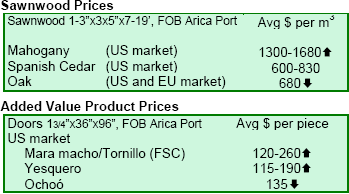
10. Guatemala
Guatemala makes progress in certification
Guatemala has 534,177 ha of FSC certified forests, of which 512,000 ha are broad leaved tropical forests and
3,362 ha are plantations of species such as teak and pine. Communities have 381,757 ha of broad leaved tropical
forests certified.

11.
Guyana
Exports of timber products expand at steady pace
Export of timber products continued to grow in 2006, with logs as the largest contributor (35.8%) to total export
earnings, followed closely by sawn timber (dressed and undressed, 34%). Dressed sawn timber remained the
second export earner followed by undressed sawn timber exports and plywood. While the volume of logs and sawn
timber showed a steady growth over recent months,
plywood volume kept fluctuating.
Overall, exports of timber products rose 12.9% in January-July 2006, compared with the same period in
2005. The Asian market continued to lead the demand for Guyanese tropical logs in July. China (49.2%) dominated
the export market, followed by India (42.9%) and Taiwan PoC (5%). The export of lesser used species climbed 47.8% in July, continuing making inroads in the
international market. UK was the leading importer of Guyana's plywood in July, increasing by 1,595.5 m3 in
volume and 24% in prices.
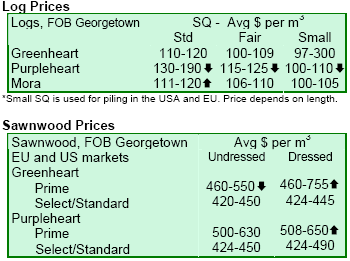
|